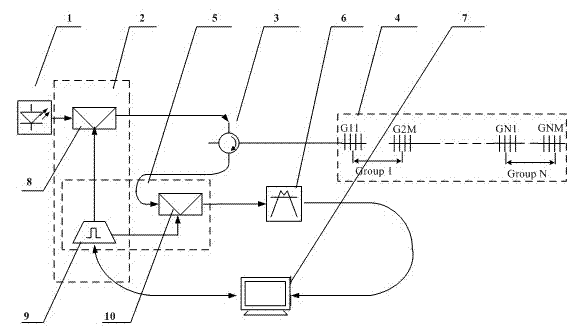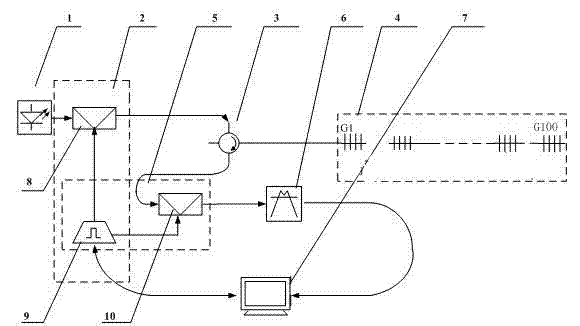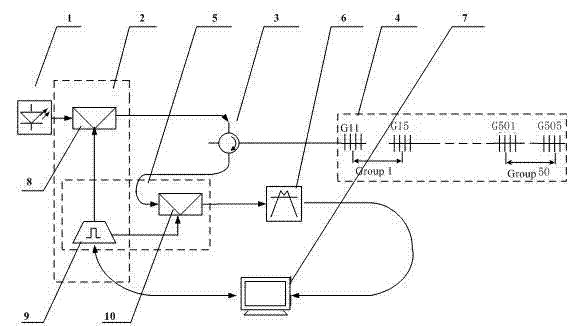Ultra-large capacity time division and wavelength division fiber grating sensing system and query method thereof
A fiber grating and sensing system technology, applied in the field of sensing, can solve the problems of pulse crosstalk, poor direct modulation characteristics, application limitations, etc., meet the requirements of reducing reflectivity, overcome large delay errors, and realize real-time acquisition. Effect
- Summary
- Abstract
- Description
- Claims
- Application Information
AI Technical Summary
Problems solved by technology
Method used
Image
Examples
Embodiment 1
[0044] To detect the temperature, take a time-division multiplexing sensing system composed of N identical fiber Bragg gratings (assuming that N is 100, the Bragg wavelength of the grating is 1303.3nm, the reflectivity is 0.25%, and the distance between the gratings is 5m) as an example. Detailed description.
[0045] The ultra-large-capacity time-division fiber grating sensing monitoring method in the present invention is to use "quasi-distributed fiber grating sensing" technology to carry out long-term and stable monitoring of the temperature of 100 monitoring points, according to figure 2 Schematic diagram of the structure of the system, and its specific implementation steps are:
[0046] 1. Determine the location and distribution of temperature monitoring points: According to the specific conditions of the monitoring site, determine the location of 100 monitoring points, preliminarily estimate the temperature value and its changing trend, and calculate the general situati...
Embodiment 2
[0052] To detect strain, use N groups, each group includes M different wavelengths (assuming N=50, M=5, the wavelengths in each group are 1296nm, 1299nm, 1302nm, 1305nm, 1308nm, the reflectivity is 0.25%, and the gratings are mutually Take a wavelength division time division multiplexing sensor system with an interval of 2m) as an example to describe in detail.
[0053] The ultra-large-capacity TWDM FBG sensor monitoring method in the present invention adopts "quasi-distributed FBG sensing" technology to carry out long-term and stable monitoring of the strain at 250 monitoring points. image 3 Schematic diagram of the structure of the system, and its specific implementation steps are as follows:
[0054] 1. Determine the location and distribution of strain monitoring points: According to the specific conditions of the monitoring site, determine the location of 250 monitoring points, preliminarily estimate the temperature value and its changing trend, and calculate the general ...
PUM
 Login to View More
Login to View More Abstract
Description
Claims
Application Information
 Login to View More
Login to View More - R&D
- Intellectual Property
- Life Sciences
- Materials
- Tech Scout
- Unparalleled Data Quality
- Higher Quality Content
- 60% Fewer Hallucinations
Browse by: Latest US Patents, China's latest patents, Technical Efficacy Thesaurus, Application Domain, Technology Topic, Popular Technical Reports.
© 2025 PatSnap. All rights reserved.Legal|Privacy policy|Modern Slavery Act Transparency Statement|Sitemap|About US| Contact US: help@patsnap.com



